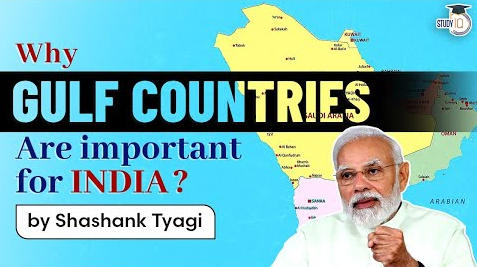Table of Contents
- Countries sharing border with the Persian Gulf are called Gulf Countries

- These countries except Iraq are part of the Gulf Cooperation Council (GCC)
What is Gulf Cooperation Council (GCC) ?
- The GCC was formed in 1981 by an agreement among Saudi Arabia, Bahrain, Oman, Kuwait, Qatar and the United Arab Emirates (UAE), that was concluded in Riyadh, Saudi Arabia.
- It is an economic and political union comprising of all the Arab countries of the Persian Gulf except Iraq.

- The grouping was formed in view of the similar political establishments in the countries based on Islamic principles, their geographical proximity, joint destiny and common objectives.
WHY GULF COUNTRIES ARE IMPORTANT FOR INDIA ?
1) TRADE ROUTE

- Can connect India directly to Europe through Gulf of Oman ,omitting long routes through Africa
2) TRADE RELATIONS

Saudi Arabia

- At a total volume of $42.9 billion in 2021-22, Saudi Arabia was India’s fourth largest trading partner.
UAE
- The UAE accounted for 6% of India’s total exports and 7.3% of imports in the last financial year, up 68.4% since the previous year (covid times)
- In terms of total trade volume, the UAE ($72.9 billion) was behind the United States ($1.19 trillion) and China ($1.15 trillion).
- Most of it was crude oil

- In 2021, India and the UAE started negotiation for a wide-ranging economic pact under India’s Comprehensive Economic Partnership Agreement (CEPA), which was completed this year.

- UAE also features in the top 10 sources of FDI inflows into India.
- “Negotiations for CEPA were launched in September 2021 and have been completed. The agreement will take India-UAE economic and commercial engagement to the next level,” India’s Ministry of External Affairs said in a statement issued in February 2022.
QATAR
- The total trade was $15 billion, accounting for just 4% of India’s total trade, but the country is India’s most important supplier of natural gas
- Qatar accounts for 41% of India’s total natural gas imports.

- Reason :- Flexible Trade Norms

2) OIL & OTHER IMPORTS

- According to Observer Research Foundation More than 84% of India’s petroleum demand, which included crude oil and petroleum products, was met with imports.
- ORF noted the India sourced Oil from 42 countries in 2020-21,up from 27 countries in 2006-07
- In 2021-2022, the largest exporter of oil to India was Iraq, whose share has gone up from 9% in 2009-2010 to 22%.
- Saudi Arabia has accounted for 17-18% of India’s oil imports for over a decade. Kuwait and UAE remain major oil exporters to India.
- Iran used to be the 2nd largest oil exporter to India in 2009-2010, its share went down to less than 1% in 2020-21, due to US sanctions.
3) Huge Remittances

- In terms of remittances from abroad, India was the largest recipient in 2020 at $83.15 billion, according to World Bank data.

- This was nearly twice the remittances to the next highest recipient, Mexico, at $42.9 billion.
4) Diversification
- The Gulf states have embarked on massive economic diversification and are investing in a variety of new projects including renewable energy, higher education, technological innovation, smart cities, and space commerce.
5) People to people ties
- Experts believe that the present diplomatic row over derogatory comments won’t impact India’s relationship with the Arab countries In long run among people
6) Power Crisis in India
- Domestic, national and global issues have, contributed to the ongoing coal conundrum in India and subsequent ‘power crisis’.
- India is currently facing a daily power deficit of 1 % from the average of 0.3 %.
- Gulf countries could be substitute

7) Huge Market
- Having the Agriculture Soil and huge population, India can be a leading exporter of food products along with mutual investor in IT Sector
8) Counter China

- As China is increasing it’s Influence Around India and Gulf Countries, it’s imperative that they join hands to stop China from gaining further strength in Asia (Both Economically and strategically )


Download | Free PDF



























 WhatsApp
WhatsApp